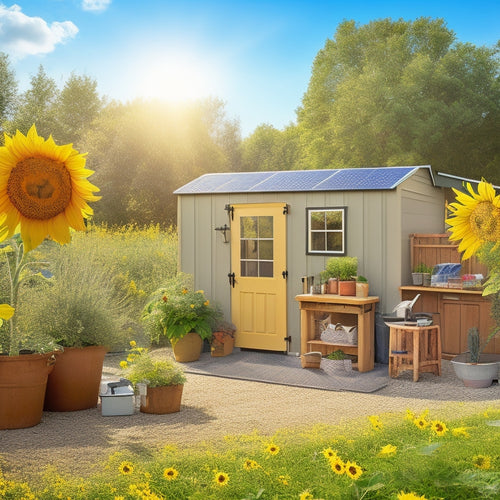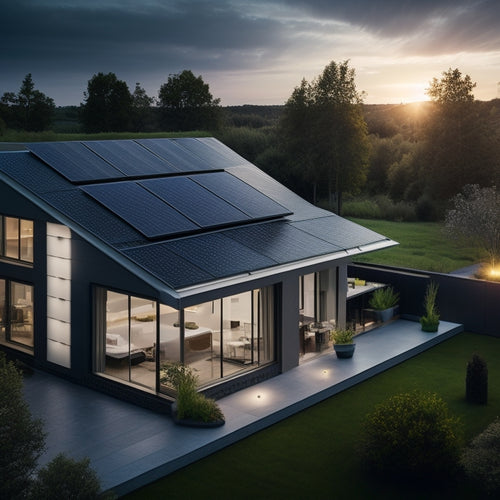
Home Battery System for Solar
Share
You're contemplating a home battery system to tap into the full potential of your solar panels, and by doing so, you're taking an essential step towards energy independence, reduced energy expenses, and a more sustainable lifestyle. A home battery system stores excess energy generated by solar panels during the day, providing power after sunset and decreasing reliance on traditional energy sources. By optimizing energy usage and reducing peak hour demand, you can lower your energy costs and achieve greater control over your energy use. As you investigate the world of home battery systems, you'll want to evaluate the latest advancements in deep cycle battery technology, inverters, and energy storage strategies to access the full benefits of solar energy.
The Essentials
- Home battery systems store excess solar energy for nighttime use, reducing reliance on traditional energy sources and promoting energy independence.
- These systems lower peak hour demand, resulting in lower energy costs by utilizing stored solar energy during peak hours instead of grid energy.
- Lithium-ion batteries are favored for reliable backup power due to their longevity and support for up to 5,000 charge and discharge cycles.
- Proper sizing of batteries ensures maximum output while maintaining battery health and performance, and assessing energy needs is crucial to determine optimal battery size.
- Ensuring inverter compatibility with battery configuration is vital for efficient and reliable operation of home battery systems for solar.
Energy Independence at Night
You want to capture the energy generated by your solar panels during the day to power your home after sunset.
With a home battery system, you can store excess energy generated during the day and use it at night, providing power after sunset.
By reducing your reliance on traditional energy sources, you can also shield yourself from fluctuating grid prices and enjoy greater control over your energy use and savings.
This nighttime energy security gives you independence from the grid and reduces your reliance on traditional energy sources.
Power After Sunset
The absence of sunlight at night doesn't mean your solar-powered home has to rely on the grid. With a home battery system, you can store excess energy generated during the day for use at night. This is made possible by solar storage solutions that optimize nighttime efficiency.
By investing in a reliable Energy Storage System, you can enjoy uninterrupted power supply and reduce your reliance on noisy, polluting generators. When the sun sets, your solar panels stop generating power, but your energy needs don't.
A home battery system bridges this gap, providing you with a reliable source of power after sunset. This means you can continue to power your appliances, lights, and electronics without relying on the grid.
Nighttime Energy Security
Energy autonomy at night becomes a reality with a home battery system, which guarantees your solar-powered home remains powered even when the sun dips below the horizon.
You can enjoy the freedom to use electricity at night without relying on the grid, thanks to the energy storage capabilities of your home battery system. By switching to a home solar power battery, you'll enjoy reduced energy expenses, uninterrupted power supply, and the freedom to be less reliant on the grid, providing a cleaner, more sustainable, and self-sufficient lifestyle for you and your family off-grid solar batteries.
During the day, your solar panels generate electricity and charge your battery. When nighttime usage kicks in, your home battery system takes over, providing a steady supply of power to your home.
This means you can continue to power your appliances, lights, and devices without interruptions, even when the grid is down or during peak hours. With a home battery system, you're in control of your energy storage and usage.
You can monitor your energy production and consumption in real-time, making adjustments as needed to optimize your nighttime energy security. By reducing your reliance on the grid, you're not only saving money on your electricity bills but also gaining independence from the utility company.
Reduced Peak Hour Demand
By installing a home battery system for solar, you'll reduce your peak hour demand, which translates to lower energy costs.
This is because you'll be using stored solar energy during peak hours, instead of relying on the grid.
With an affordable solar battery backup system off grid solar battery backup, you'll have the freedom to choose when to use your stored energy.
Lower Energy Costs
When you generate your own solar power, you're already taking a significant step towards reducing your reliance on the grid and cutting your energy bills.
However, with a home battery system, you can further maximize your energy savings. By storing excess energy generated during the day, you can use it to power your home during peak hours when utility rates are highest. This reduces your peak hour demand, resulting in significant cost reduction.
With a home battery system, you can optimize your energy usage and reduce your reliance on the grid. You'll be able to store excess energy generated during the day and use it when you need it most, reducing your energy consumption from the grid during peak hours.
This not only reduces your energy bills but also helps you achieve greater energy independence. By reducing your peak hour demand, you'll be able to enjoy significant energy savings and cost reduction, giving you the freedom to live life on your own terms.
Shift Peak Usage Time
With a typical household's peak energy usage occurring between 4 pm and 7 pm, a home battery system enables you to shift this peak usage time to off-peak hours. This means you can reduce your reliance on the grid during peak hours, reducing your energy costs and lowering your carbon footprint.
By implementing peak shaving and load shifting strategies, you can optimize your energy usage and take advantage of off-peak rates. Here's how it works:
| Time of Day | Energy Usage |
|---|---|
| 4 pm - 7 pm | High (Peak) |
| 9 pm - 12 am | Low (Off-Peak) |
| 12 am - 6 am | Very Low (Super Off-Peak) |
With a home battery system, you can store excess energy generated during the day and use it during peak hours, reducing your energy bills and dependence on the grid. This not only saves you money but also gives you the freedom to control your energy usage and reduce your environmental impact.
Deep Cycle Battery Technology
You'll want to contemplate the battery lifespan expectations when selecting a deep cycle battery for your solar home battery system, as this will impact the overall cost of ownership.
When it comes to reliable backup power, lithium-ion batteries are a popular choice due to their long shelf life.
The cycle depth and capacity of the battery also play a critical role, as they determine how efficiently the battery can be charged and discharged.
Battery Lifespan Expectations
Five to fifteen years is a typical lifespan expectation for deep cycle batteries in a home battery system for solar, depending on various factors such as the type and quality of the battery, operating temperatures, and the depth of discharge (DOD).
To give you a better understanding of what to expect, here is a breakdown of the average lifespan of different deep cycle battery types:
| Battery Type | Average Lifespan | Warranty Period |
|---|---|---|
| Flooded Lead-Acid | 5-7 years | 1-2 years |
| AGM (Absorbed Glass Mat) | 7-10 years | 2-5 years |
| Lithium-Ion | 10-15 years | 5-10 years |
You can maximize your battery's lifespan by following proper battery maintenance tips, such as keeping the batteries at a moderate temperature, avoiding deep discharges, and ensuring they're not overcharged. Additionally, warranty considerations should be a key factor in your purchasing decision, as a longer warranty period can provide you with peace of mind and protect your investment. By doing your research and choosing the right battery for your home solar system, you'll be well on your way to achieving energy independence.
Cycle Depth and Capacity
One crucial aspect of deep cycle battery technology is the cycle depth and capacity, which directly impact the battery's overall performance and lifespan. You need to understand these factors to guarantee you're getting the most out of your home battery system for solar.
Cycle depth refers to the percentage of the battery's capacity that's used during each discharge cycle. For example, if you use 50% of the battery's capacity, the cycle depth is 50%. Deeper cycle depths can reduce the battery's lifespan, so it's vital to find a balance between usage and longevity.
When it comes to capacity, you need to evaluate your energy requirements and battery sizing. A larger capacity battery may provide more energy, but it's also heavier, more expensive, and may have lower charge efficiency.
You'll need to assess your energy needs and determine the best battery size for your system. By doing so, you can guarantee you're getting the most out of your deep cycle batteries while maintaining their overall health and performance.
Check Your Inverter Compatibility
When selecting a home battery system for your solar setup, you'll need to verify the inverter is compatible with your battery configuration.
The type of inverter you have matters, as it affects how your battery is charged and discharged. For instance, popular home battery solutions like Tesla Powerwall and LG Chem RESU require specific inverter compatibility.
You'll also need to take into account the battery connection options, which will impact the overall performance and efficiency of your system.
Inverter Type Matters
Selecting a compatible inverter type is crucial for a seamless home battery system integration with your solar setup. You want to confirm that your inverter can efficiently convert DC power from your solar panels to AC power for your home. Inverter type matters because it affects your system's overall performance, particularly regarding inverter efficiency and grid interaction.
| Inverter Type | Characteristics |
|---|---|
| String Inverter | Centralized, high-power, and cost-effective. Suitable for small to medium-sized systems. |
| Microinverter | Decentralized, high-efficiency, and flexible. Ideal for complex or shaded systems. |
| Power Optimizer | Hybrid approach, combining the benefits of string and microinverters. Offers high efficiency and flexibility. |
| Hybrid Inverter | Combines a grid-tie inverter with a battery inverter, enabling both grid interaction and off-grid functionality. |
When choosing an inverter, consider factors such as your solar panel configuration, system size, and energy storage requirements. Confirm that your inverter is compatible with your battery type and can handle the required power output. By selecting the right inverter type, you'll maximize your system's efficiency, reliability, and overall performance.
Battery Connection Options
Your inverter choice greatly impacts your home battery system's performance, and now it's time to investigate how to connect your batteries to it. When selecting a connection type, consider factors like battery sizing, installation considerations, and maintenance practices.
You'll want to confirm your inverter is compatible with your battery bank, and that the connection type supports your energy monitoring and charging strategies. Common connection types include DC-coupled, AC-coupled, and hybrid configurations. Each has its pros and cons, so it's crucial to evaluate your specific needs and system requirements.
Safety protocols, such as overcharge protection and ground fault detection, should also be integrated into your connection design. Additionally, consider system integration, performance metrics, and warranty options when choosing your connection type.
Lithium-Ion Batteries Last Longer
When you choose a lithium-ion battery for your home solar system, you'll benefit from a longer cycle life.
This means you can expect your battery to support up to 5,000 charge and discharge cycles, considerably outlasting other battery types.
With a longer cycle life, you'll reduce your replacement costs and enjoy a lower cost of ownership over the long haul.
Longer Cycle Life
By the time you've invested in a home battery system for solar, you've likely considered the long-term benefits. One vital aspect of this investment is the longer cycle life of lithium-ion batteries. A longer cycle life means your batteries will last longer, reducing the need for frequent replacements and saving you money in the long run.
To maximize your battery's lifespan, it is important to follow proper battery maintenance tips and charging efficiency strategies. Here's a breakdown of how different factors affect your battery's cycle life:
| Factor | Cycle Life Impact | Recommendation |
|---|---|---|
| Depth of Discharge (DOD) | Higher DOD reduces cycle life | Keep DOD below 80% |
| Temperature | High temperatures reduce cycle life | Keep batteries between 20°C and 30°C |
| Charging Cycles | Increased charging cycles reduce cycle life | Optimize charging schedules |
| Maintenance | Poor maintenance reduces cycle life | Regularly inspect and clean batteries |
Frequently Asked Questions
Can I Install a Home Battery System Myself?
You can attempt a DIY installation, but it's essential to weigh the risks: improper connections can lead to safety hazards and void warranties, making battery maintenance a nightmare; consider hiring a pro for a hassle-free experience.
How Long Does a Typical Battery Installation Take?
Fastening fusion of functionality, you'll find that a typical installation timeline fluctuates from a few hours to several days, depending on battery types, system complexity, and your level of electrical proficiency.
Are Home Battery Systems Affected by Extreme Temperatures?
You'll find that extreme temperatures can impact battery performance efficiency, affecting its lifespan through temperature effects. Effective thermal management systems help mitigate this, but it's essential to take into account these factors when selecting a battery to guarantee peak operation.
Can I Charge My Battery From the Grid if Needed?
Imagine filling a gas tank on a road trip - you can top it off at a station if needed. Similarly, you can charge your battery from the grid if needed, thanks to advanced grid charging and smart battery management systems that guarantee efficient energy flow.
Are Home Battery Systems Covered by a Warranty?
You'll typically find that battery systems come with a warranty offering coverage for a certain number of years or cycles, ensuring your investment is protected; the warranty often guarantees a minimum battery lifespan, giving you peace of mind.
Final Thoughts
As you utilize the power of solar energy, remember that a home battery system is the key to releasing true energy independence. With the ability to store excess energy generated during the day, you'll be powered up even when the sun dips below the horizon. It's not just about reducing peak hour demand, it's about taking control of your energy future. And with advancements in deep cycle battery technology and lithium-ion batteries that last longer, the possibilities are endless. The future is bright, and it's yours to capture.
Related Posts
-

Building an Emergency Backup Solar Power System in 5 Essential Steps
Building an emergency backup solar power system involves five key steps. First, assess your daily energy needs to ide...
-

Top Portable Refrigerators for Camping Adventures
When you're camping, having a reliable portable refrigerator can make all the difference for keeping your food fresh ...
-

Home Solar Battery
You're opting for a home solar battery that allows you to utilize the power of the sun during the day and use it at n...


